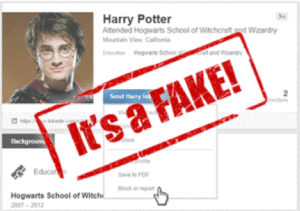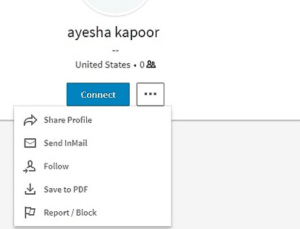LinkedIn, the powerful networking platform for business professionals, has exploded in growth over the past few years. However, with its rapid expansion, LinkedIn – like all other social media platforms – has experienced a growing problem with fake profiles.
In too many cases, these scammers have pieced together information from other profiles, along with a good-looking photo, in an attempt to make the request look legitimate. But connecting with a fake LinkedIn profile can give scammers access to important and powerful information about you, such as details about your history, company and professional contacts.
That information can be used to craft detailed and believable phishing and other scams. Because of this threat, it’s best to know how to spot fake LinkedIn profiles, and to make sure you don’t connect with them.
In this post, I’m going to cover nine things to look for when trying to work out if a LinkedIn profile is legitimate to save you from the pitfalls of the process.
1. Fake Photos
All too often, fake LinkedIn profiles are accompanied by ridiculously good-looking model-quality photos.
Often, scammers will use the photo of a lesser-known actor or actress, or even an image of well-known public figure. Other scammers use photos of real people, but not the “person” in the profile, and sometimes create multiple fake LinkedIn profiles utilizing the same picture.
If you’re suspicious or not sure about a photo, there’s an easy way to check its authenticity. Simply do a reverse image search using TinEye, Bing or Google’s Reverse Image Search. These search engines will show you where, if any place, the same image has been used previously online.
Here’s a great example of a fake photo – “Alex Flood” lives in the United Kingdom, and is a Travel Writer and Photographer. Previously, he was a “Marketing Recruitment Consultant” (a fairly vague job description), but the tip-off is his photo:

Alex’s photo is actually that of a model – a quick search on TinEye shows where the scammer got his profile pic:

Images of celebrities are also a good giveaway, as are images of women in suggestive looking poses. A dead ringer for a fake profile is one where the image is of a woman, but the profile has a man’s name (or vice versa).
2. Incomplete Profile
One common signifier of fake LinkedIn accounts is the lack of any real information about the individual. If there is information, it’s often in the form of mostly generic statements that lack any specificity in the summary and experience sections.
Genuine profiles of real people typically include a mixture of personal details, such as causes, volunteering, hobbies, education, recommendations, and the use of the first person when writing the ‘Summary’ or ‘Experience’ sections. Many fake profiles don’t bother to add personal information but keep their “profiles” at a bare-bones with minimum of insight.
In addition, generic job titles can also be a tip-off. If you get a suspicious request from someone with the simple job title of “Manager,” that should trigger your Spidey senses to investigate further.
3. Limited Connections (often under 100)
A genuine profile will have a good mix of people and profiles among its connections – so if you find a profile with either all the same or all opposite gender people with fake looking profile pictures, steer clear.
Checking out mutual friends from a connection request is another helpful tool in confirming the validity of a LinkedIn profile. Some of today’s fake profiles look so real that even the smartest of social media users can be fooled.
Fake profiles can have several hundred connections already, as well as a handful of skill endorsements. They also usually belong to several groups, and follow a couple of companies and influencers.
4. Fake Name
The name used will often be generic in nature, or that of a very famous person, like an actor, actress or television personality.
Some more clever hackers will use the name of a more obscure actor or actress that wouldn’t be as known to most of those on LinkedIn (the below is obviously not an example of the latter)

5. Poor Spelling & Grammar
In many fake profiles, there are some clear presentation errors, such as misspellings and poor grammar.
Often, the first name is displayed in all capital letters, or all lowercase, which is not a protocol for presenting your name on a professional network. Also, odd spellings of common names, colloquial spellings of company names in the work history, or other typos in the profile should be a red flag.
6. Suspicious Work History
Not everybody who receives an education from a prestigious university gets a great job. But if a profile lists that type of education, yet the work history is that of someone with more of a “menial” job, it should at least make you think twice about the profile, and whether to connect with that person. If the trajectory of work experience seems odd or off, it probably is.
Also, a growing number of fake LinkedIn profiles are related to recruiters, as that service appears to be a plausible reason to connect with someone you don’t know. Check other work experience and facets – or better yet, look for their current employer elsewhere online and see if the person with the suspect profile is, in fact, listed as working there.
7. Suspect Connection Requests
If you get a request from Bill Gates, Warren Buffett, Richard Branson or someone else who isn’t likely to send you a LinkedIn request, I can assure you it’s not them, but a scammer.
Less obvious are those who’ve figured out how to pose as authentic, boring, cubicle-office dwellers.
According to USA Today, last fall, hackers stole and posted over three terabytes of files from a music video in a breach that began with a single phishing attack through LinkedIn. The group OurMine claimed responsibility.
You should always spend a moment investigating before you click accept.
8. Lack of Engagement
Social media is designed to foster two-way conversation – so those accounts that don’t interact with others are often phony.
One tip-off is accounts that feature very little in the way of updates and content, and lack any real conversations or engagement with other community members.
Another common sign of a fake account is one that doesn’t tend to have anyone following the account back.
9. Pitches for Great Business Opportunities or Jobs
While job hunters use LinkedIn to connect with former colleagues and potential employers, scammers also use the service to find targets. So, as a LinkedIn user, also be on the lookout for suspicious “recruiters” and job offers.
According to the Better Business Bureau, the scam often begins when you get a LinkedIn message asking you to apply for a job. The message comes from someone who appears to be a recruiter, and their LinkedIn profile looks real. You may even have several connections in common.
From here, the scam has a couple of variations. Sometimes, the message contains a link that appears to point to an online job application. You’re supposed to upload your resume, and may be asked to provide personal information – which can range from your address to Social Security/Social Insurance Number. Other times, you respond to the message and are “hired” for the job. Then, you’re asked to pay upfront for training and/or others expenses.
No matter how the scam unfolds, the job never materializes – the scammer simply takes the money and/or information and disappears, and those who share any personal information run the risk of being victimized by identity theft.
What I Look for Before Accepting a LinkedIn Connection Request
Here are some of the checks I have in place when deciding whether or not to accept a connection request.
- Your profile includes a headshot and not a stock image or logo
- Your headline is professional
- Your profile, especially your headline is free of typos
- You have at least 500+ connections (more than anything this tells me you didn’t just throw up a fake account this past week)
- You have a completed summary section sharing a little about who you are
- Your profile is relatively complete
- You’ve engaged with one my posts or with me on another social network
- You’re not promoting yourself as a L.I.O.N. (read: Why I Don’t Connect with L.I.O.N.s on LinkedIn)
- Your profile is free of suspicious inconsistencies

When You Come Across a Fake LinkedIn Profile…
If and when you do come across a fake profile, you can also report it to LinkedIn.
Click ‘Report/Block’ to file the report and the reason, and help keep LinkedIn as a safe networking platform for you and your connections.

Conclusion
It’s unrealistic for business professionals to keep a closed profile when social media is a resource for finding potential prospects and new connections. You just need to be careful and filter through the types of people you want to connect to.
But by using common sense, and by utilizing the suggestions made here, you’ll be well equipped to avoid scammers and phishing schemes that seek to rob you of your identity and professional contacts.
As you learn how to spot a fake LinkedIn profile and report it, you’ll not only avoid the pitfalls of connecting with the wrong people, but you’ll also help the LinkedIn community and your fellow business professionals keep the site safer for everyone, and a place where your business can thrive.
This post was first published on the Top Dog Social Media blog.
